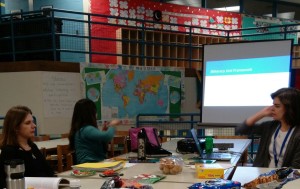Our Book Study Meets about Chapter 1: Foundations in Teaching for Biliteracy
Our book study “kick-off” at Barbieri Elementary School was after school on October 27, 2015. A parallel book study group was meeting monthly at another school within our district, Brophy Elementary School. Since each school has its own culture and different programs, the book study meetings were organized slightly differently.
Both book studies were designed by instructional coaches. At the Barbieri School, the school Literacy Coach collaborated with the ELL Coach to submit a plan to the Barbieri Principal and the Director of Bilingual Education. At the Brophy School, the ELL Coach coordinated with teachers to choose the best days and the general structure for the sessions. Teachers were invited to sign up with the promise of a free Teaching for Biliteracy (Beeman & Urow) book and 10 professional development points for full participation in monthly meetings.
At Brophy School, a small number of participants, including several transitional bilingual Spanish teachers and several English language development teachers, participate in deep discussions about the topics. At Barbieri School, about 20 participants, including dual immersion and English language development teachers, comprise a lively group.
In both groups, we “set the stage” at the first meeting by reviewing key points from the summer institute with Cheryl Urow. (You can find out more about this year’s summer Teaching for Biliteracy institute with Cheryl Urow here.)
In setting the stage at our first session, we focused on several key points:
We reminded ourselves about the important work of supporting developing bilinguals. In our Two-Way program, Spanish time must be sacred. Since English is the dominant language in our society, we must be vigilant about not letting it encroach into Spanish. Cheryl’s emphasis on effective strategies for building oracy aligns nicely with a professional development focus at our school on academic conversations, along with a district-wide focus on making thinking visible. A focus on oracy will:
- Allow all students to participate in an active, meaningful way, regardless of language proficiency level.
- Explicitly build student receptive and productive language.
- Maintain and build language while building background knowledge.
- Provide opportunities for students to interact about their thinking and reasoning.
We also reviewed the idea of the Bridge between languages, and many teachers commented that they looked forward to implementing the Bridge. The Bridge is the instructional moment when teachers guide students to engage in contrastive analysis of the two languages and transfer academic content.
(This webinar by Cheryl Urow is a great tool for setting the stage and beginning a discussion around these key points.)
At the Barbieri School, we divided chapter 1 into sections to read and synthesize. We utilized a cooperative learning strategy and ask groups of three or four teachers to work together on a section of text. These “expert groups” then reported back to the whole group. Topics were:
1. teaching for biliteracy (pp. 2-3)
2. the bridge and bridging (pp. 4-5)
3. sociolinguistic premises (p. 5)
4. contrastive analysis, unit framework, program considerations (p. 19)
It took about fifteen minutes to analyze the readings and ten minutes per group to report back.
Prior to our first meeting at the Brophy School, on the other hand, we decided to read Chapter One: Foundations in Teaching for Biliteracy on our own, and dive right into chapters two and three at the first meeting. At both schools, during our first meeting of the book study, we all signed up to facilitate an upcoming session. Here is a copy of our schedule at Brophy School:
| Date | Chapter to discuss | Name of Facilitator |
| 10/28/2015 | Chapter 2 Students: A Multilingual Perspective & Chapter 3 Teachers: Capitalizing on Life Experiences | Sara |
| 11/18/2015 | Chapter 4 Planning the Strategic Use of Two Languages | Beth |
| 12/16/2015 | Chapter 5 Language Resources, Linguistic Creativity, and Cultural Funds of Knowledge | Erika |
| 1/27/2016 | Chapter 6 Building Background Knowledge | Yaribel |
| 2/24/2016 | Chapter 7 Reading Comprehension | Jen F. |
| 3/30/2016 | Chapter 8 Writing: A Multilingual Perspective | Sara |
| 4/27/2016 | Chapter 9 Word Study and Fluency: The Dictado and Other Authentic Strategies | Gabriella |
| 5/25/2016 | Chapter 10 The Bridge: Strengthening Connections between Languages | Sara |
And here is another sample book study schedule.
At Barbieri School, we signed up to facilitate with a group of two or three teachers. As we committed to a chapter in advance, we agreed to become knowledgeable about the key points in that chapter and try out some of the strategies in our classrooms. As we shared the responsibility for facilitating, we gained confidence with trying new teaching methods and reporting back to the group.
Our teachers are all strong bilingual and bicultural educators who are willing to experiment with innovative teaching techniques. We are open to carefully observing our students’ language use and implementing the Bridge to meet their linguistic needs.
Later this month, I will blog in more detail about the ideas that we tested and shared and the reactions of our bilingual students.
Barbieri Bridging Book Study Group


